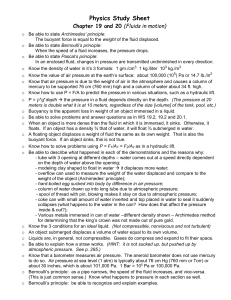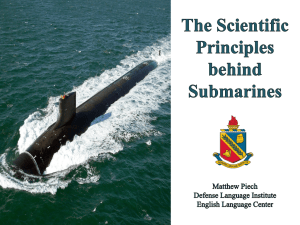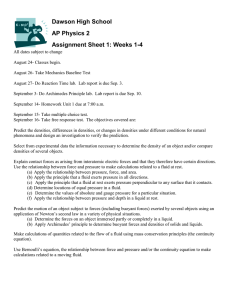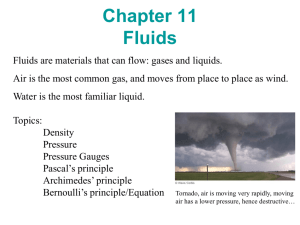PPT - Lawless Teaching : Home
advertisement
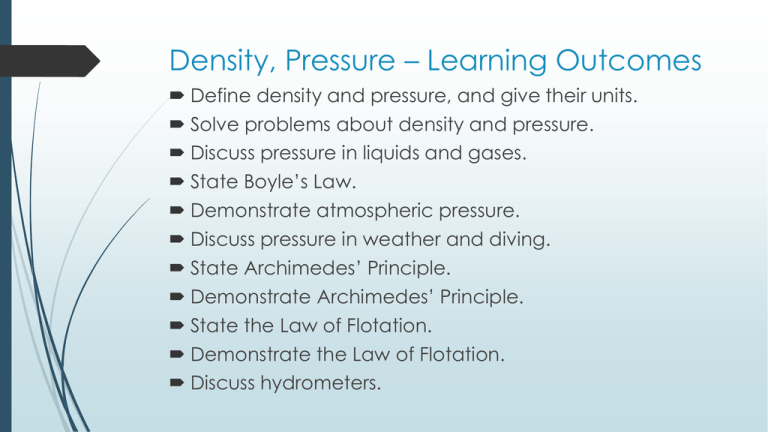
Density, Pressure – Learning Outcomes Define density and pressure, and give their units. Solve problems about density and pressure. Discuss pressure in liquids and gases. State Boyle’s Law. Demonstrate atmospheric pressure. Discuss pressure in weather and diving. State Archimedes’ Principle. Demonstrate Archimedes’ Principle. State the Law of Flotation. Demonstrate the Law of Flotation. Discuss hydrometers. Density The density of a substance is its mass per unit volume. Formula: 𝜌 = 𝑚 𝑉 ρ = density, m = mass, V = volume. It is a scalar quantity, measured in 𝑘𝑔/𝑚3 e.g. A piece of wood has mass 80kg and volume 100m3. Find its density. e.g. A cubic block of gold has length 120cm and density 19 300kg/m3. Find its mass. Density 𝜌= 𝜌= 𝑚 𝑉 80 100 𝜌 = 0.8 𝑘𝑔/𝑚3 𝑉 = 1.23 = 1.728 𝑚3 𝑚 =𝜌×𝑉 𝑚 = 19 300 × 1.728 𝑚 = 33 350.4 𝑘𝑔 Pressure Pressure is force per unit area. Formula: 𝑃 = 𝐹 𝐴 P = pressure, F = force, A = area It is a scalar quantity, measured in Pascals (Pa). e.g. Cian leans on his table with a force of 30N. If his elbow has an area of 0.015m2, what pressure is he exerting on the table? e.g. Atmospheric pressure is ~100kPa. If a circle on the ground has radius 10cm, what force is the atmosphere exerting on the circle? Pressure 𝑃= 𝐹 𝐴 𝑃= 30 0.015 𝑃 = 2𝑃𝑎 𝐴 = 𝜋𝑟 2 = 𝜋 × 0.1 2 ≈ 0.0314𝑚2 𝐹 =𝑃×𝐴 𝐹 = 100 000 × 0.0314 𝐹 = 3140𝑁 Pressure in a Fluid The pressure in a fluid increases with depth. Formula: 𝑃 = 𝜌𝑔ℎ P = pressure, ρ = density, g = acceleration due to gravity, h = height / depth Pressure acts perpendicular to any surface immersed in the fluid. At equal depths, the pressure is the same. Pressure in a Fluid e.g. Kevy is going scuba diving off the coast of Mayo. What pressure is the water exerting on him if he is 10m below sea level? e.g. Find the pressure, due to the water, at a depth of 33m in water. e.g. A can of height 10 cm is submerged in water. What is the difference in pressure between the top and bottom of the can? Pressure in a Fluid 𝑃 = 𝜌𝑔ℎ 𝑃 = 1000 × 9.81 × 10 𝑃 = 98 100𝑃𝑎 𝑃 = 𝜌𝑔ℎ 𝑃 = 1000 × 9.8 × 33 𝑃 = 323 400𝑃𝑎 𝑃 = 𝜌𝑔ℎ 𝑃 = 1000 × 9.8 × 0.1 𝑃 = 980𝑃𝑎 Boyle’s Law Boyle’s Law: The volume of a fixed mass of gas is inversely proportional to its pressure at constant temperature. Formula: 𝑝 ∝ 1 𝑉 or 𝑝𝑉 = 𝑘 p = pressure, V = volume, k is a constant for a particular gas. e.g. A pressurised gas doubles its volume when some of the pressure is relieved. By what factor did the pressure change if the temperature remained constant? e.g. The volume of a fixed mass of gas is 600cm3 at a pressure of 1×105Pa. Find its volume when the pressure changes to 3.2×105Pa if the temperature remains constant. Boyle’s Law Double volume ⇒ Half pressure 𝑃1 𝑉1 = 𝑃2 𝑉2 1 × 105 × 600 = 3.2 × 105 𝑉2 𝑉2 = 187.5𝑐𝑚3 Boyle’s Law e.g. A small bubble of gas rises from the bottom of a lake. The volume of the bubble increases threefold when it reaches the surface of the lake where the atmospheric pressure is 1.01 × 105 𝑃𝑎. The temperature of the lake is constant. Calculate the pressure at the bottom of the lake and the depth of the lake. Volume increases threefold upwards ⇒ pressure is three times as much at the bottom of the lake. ⇒ 𝑃 = 3 × 1.01 × 105 = 3.03 × 105 𝑃𝑎 (due to atm. + water) 𝑃 = 𝜌𝑔ℎ 2.02 × 105 = 1000 × 9.8 × ℎ (subtract 1.01 × 105 from atm.) ℎ= 2.02×105 1000×9.8 = 20.6𝑚 Weather and Diving High pressure -> clear, sunny, dry, still air. Imagine the high pressure pushing the clouds away. Low pressure -> cloudy, wet, windy. Imagine all the clouds being pushed into low pressure areas. As you dive deeper, pressure increases. This causes excess nitrogen (79% of air) to be dissolved in your blood. If you surface too quickly, the nitrogen will form bubbles as the pressure decreases. These bubbles are dangerous and potentially fatal. The “cure” is to stay in a decompression chamber where the pressure can be slowly decreased to normal levels. Divers’ air supplies sometimes have increases oxygen levels to reduce this possibility. Archimedes’ Principle Archimedes’ Principle states that a body wholly or partially immersed in a fluid will experience an upthrust equal to the weight of the fluid displaced. To Demonstrate Archimedes’ Principle 1. Fill an overflow can with water until it overflows. 2. Place an empty graduated cylinder underneath the spout of the overflow can. 3. Attach an object to a spring balance and note the reading. 4. Immerse the object in the overflow can and note the new reading on the spring balance. 5. Note the weight of the water in the graduated cylinder and compare it to the difference in weight of the object. Result: The displaced water and the upthrust on the object should be the same, verifying Archimedes’ Principle. Law of Flotation The weight of a floating body is equal to the weight of the fluid it displaces. Hydrometers are designed to float at different levels depending on the density of the fluid it is immersed in (the weight of the hydrometer will be displaced with less volume in denser fluids). Hydrometers are used to find: the percentage of alcohol in beverages. the percentage of fat in milk. the density of sulfuric acid in a lead acid battery.

